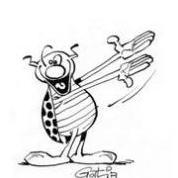Search the Community
Showing results for tags 'minuet'.
-
.
-
This is my 5th minuet and trio from a series of 6. I tried to make each of these minuets unique and not in the style of Mozart or Haydn which is difficult. I set myself the restraint of only one note per hand so that it's suitable for beginners. My playing is a little hurried because I get nervous as soon as I press record and then I make mistakes. I can't get back those wasted 2 minutes! The pressure is intense! The trio is contrasting to the minuet in style and texture which maybe too much variety to be considered balanced. This problem infected my 6th minuet and trio too. For my next set of 6 I will endeavour to compose closer to the style of the late 18th century with greater unity and the use of more common phrase structures of the period. Thank you for listening.
-
Who could have said I would start to write this kind of pieces? I am very fond of contemporary languages, of course. Now and then, I wrote a piece in what I thought it was a baroque style.... But I was wrong. Some weeks ago I began to study Music from its very beginning: cantus firmus, monophony, primitive polyphony, counterpoint, etc..... ALL of the music we know today comes from those times. Schemata is a big set of harmonic and melodic patterns flourishing in the galant style. However, many of them were born many many years before, and on the other hand, they were going to be present in music forever. So, now I find myself writing Minuets, or short pieces, just to learn these schemata. I love them and I love the endless ways to combine them, and now I really understand what baroque is. But most important, I know this stuff will have a principal role in my future projects whatever language they use. Two short minuet-trio with notated schemata.
-
I added a trio to the minuet i composed recently. I found recording myself playing gave me performance anxiety and caused continuous mistakes. It was quite frustrating but I managed to get a somewhat decent recording with only a couple of minor mistakes. The minuet is Haydnesque but I experimented with the trio. I used doubled thirds to sound like a trumpet fanfare which is answered by the strings. A back and forth ensues which leads to a waltz like dance over a tonic pedal. I bought a book of minuet and trios recently by Haydn. In the first two minuet and trios of the book Haydn keeps the same key throughout the minuet and trio which i thought was unusual but uses tonicisations to add colour. I did the same and modulated briefly from F major to G minor in the B section of the trio rather than the relative minor to add more tension with the A section trumpet motif. I'm not 100% sure the trio works but I spent hours at the piano trying out many different approaches to create something new. In the score, one thing to note that bars 4 and 17 have two accidentals that are overlapping which obscures what they are, a B natural and an A flat.
-
Hello everyone, I just finished composing a really short minuet for guitar and piano. I was not planning to compose it but I kinda want to practice some of my pieces in real instruments and I can only (barely) play piano and guitar. I tried to compose in a little bit more modern style than what I am used to, so the piece ended up having a much more modern sound to what I usually compose (particularly the section B). Not sure whether I pulled it off or not, though. As always, any feedback, suggestion or comment is appreciated! Hope you like it!
-
A short piece exploring contrasts between legato and staccato.
-
This minuet might be better described as a scherzo.
-
This minuet is experimental and not in the galant style.
-
A minuet for solo flute. I thought about adding a cello accompaniment which I may do later.
-
Attached is the third movement of my piano trio. (yes completed before the second) I'm quite pleased as I wrote it very quickly for my standards. It's in minuet and trio form and is very short. please leave any thoughts down below.
-
Im undecided if I like this piece. I think i might hate it. The theme is quite annoying. I do like the combo of flute and cello though.
-
Hi! Minuets are trendy here it seems, and I've been recommended to try my hand at some. So here is a first minuet and trio for piano and flute. I feel it would be hard to dance on it, I realized I'm not very comfortable with a ternary rythm (and I forgot halfway that it was supposed to be a dance at all). The overall structure is: minuet1 - trio - minuet 1', where: minuet 1 is written in 2 parts for piano. It is made of 2 repeating sections [A] and [B-A']. A finishes on a half-cadence, B modulates and brings contrast, A' is same as A but ending on a perfect cadence the trio is in the key of dominant and the flute comes in. Its structure consists of 2 repeating parts [A] and [ B] (yeah, ok, I'll admit that I forgot A' and I was too lazy to change haha. But I think it's not too bad to have a bit less repetition) minuet 1' is the same as minuet 1 but without the repeats (thank god) Let me know if you have any comment/recommandation/suggestion/corrections 🙂 menuet #1 v2.mp3
-
Im enjoying composing minuets and marches for beginners on the piano. They are very simple and easy to play. The B section of this minuet is experimental for me, I've tried my hand at counterpoint.
-
Im sorry for spamming the piano forum. In future I'll group my compositions under one thread. These two pieces are for beginners.
-
A minuet for flute and cello in D. I called it The Dancing Soldier because the melody sounds like a march.
-
In this minuet I use a three stage monte. I think I have quoted Mozart in the last few bars, possibly the minuet from symphony 40.
-
The B section of this minuet only repeats 4 bars of A rather than the whole 8 bars which is common in short keyboard minuets of the galant style.
-
Hello everyone! Recently I started reading Schoenberg's "Fundamentals of Musical Composition" and I decided to write several compositions of the simple forms from the book to try to apply what I learn. The first form was the minuet and this is the first minuet I composed. I composed it in a rather free way (I plan to compose a few stricter shorter minuets next, trying to make them simpler since I keep overcomplicating things when composing). The piece follows the minuet [:A:][:BA':] form with the following tonalities and number of measures: - A: 16 measures in G major - B: 20 measures in D major - A': 17 measures in G major Any feedback is appreciated. Thank you for listening! 🙂
-
Another minuet. Ive tried to use schemas in this composition such as the fonte and prinner. Minuet_in_Eb.mid
-
This minuet is more baroque than galant in style. I think I'll take a break from composing now and study some more. Thank you to all those that have listened to my music and given me feedback, ive learned alot these past two weeks or so.
-
Another minuet. The main theme was hard to 'unmodulate' in the second section, i cant tell if it sounds awful or not.
-
Im learning melody writing and using the minuet form. Ive written a few minuets for piano so far and i will most likely add a base for this melody.
-
This minuet flirts with modulating but remains in G. Section A is 8 bars and section B is 16 bars which is quite typical of short keyboard minuets. I expanded the transition back to the main theme using only a G chord that rises using triplets, im not quite sure if it works.
-
Does the theme sound more like its in D major because of the G natural used at the start?
-
More of a joke than a minuet







